Home | Front Page | Blog | Index | New | Contact | Site Map
NuevoLeon
Coahuila
Chihuahua
Sonora
Durango
Jalisco
Sinaloa
Zacatecas
San Luis Potosi
Queretaro
Guanajuato
Michoacan
Guerrero
Morelos
Puebla
Tlaxcala
Oaxaca
Chiapas
Campeche
Yucatan
Quintana Roo
Teotenango
Xochicalco
Monte Alban
Mitla
Palenque
Uxmal
Chichen Itza
Tolum
Belize Mayans
Tikal
Copan
General Topics
Churches
Beach Bumming
Swimming Along
States
Websites
Map
Car Costs
> USA-Britain
USA 2003
USA 2002
Britain 2002
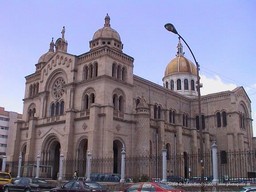
Templo del Sagrado Corazon |
On our fall trip, we arrived in Durango about an hour after dark following our first time driving in Mexico after night fall. It is an experience we will strive not to repeat. We weren't afraid of bandits, even if we ought to have been. No, for us the more urgent problems were seeing, or not seeing rather, obstacles in the road. Modern Mexican toll highways are of a very high standard, as are the main intercity non-toll highways, but get even a smidgen off the beaten track and you are likely to run into potholes. Sometimes more sometimes fewer, but you can never predict when one will appear before you and in the dark... Well, you see (ha! ha!) what we mean. There are few drivers aids on these roads. Nary a cat's eye or even a white line to demarcate the lanes or the shoulder. And, of course, this road, like most of those we have driven, was two lanes only and so there was also the problem of cars being in your lane while overtaking.
Our problem was compounded by the untimely arrival of rainfall. The rain was light, but enough to smear up our windshield and make driving against oncoming cars a blinding experience. I should add that because of the poor quality of the roads in Mexico, most people go in for high-clearance vehicles like pickups and SUV's. For drivers of low-slung cars like us, that means headlights that even when dimmed shine directly in your eyes.
Luckily, not too long after it got really dark, Gerry found a large truck ahead of him and determined to stick close to him since he was certainly able to find the road better than us and at least we would not be in danger from reckless overtakers. Well, we made it in one piece, but were never so thankful to see a city's street lights as when we arrived on the outskirts of Durango.
We had a little trouble orienting ourselves as we drove toward the center of town, as we had no map of Greater Durango, only of the city center. We made a wrong turn and found ourselves heading out of the city toward a modern industrial suburb. On the way back into town, we passed a large motel called Campo Mexico that in the artificial light looked a little beyond our budget, but it had one essential feature: secure parking for our car. Gerry went in and was very surprised after some haggling to get a room well within our budget. In daylight, we understood the reason why. The motel had been built in the 60's for American movie stars coming to Mexico to make Westerns. It had been built to very high standards for those days, with very big air-conditioned rooms, all with private bathrooms. By now, of course, the glory had faded and the rooms were a little beat-up. But we were very happy. We had lots of space, the linens and towels were all clean. The car was parked right outside. And we were off the main street and so had a very quiet sleeping environment. We liked it and Durango so much we stayed for two weeks.
One of the contributors to our positive view of Durango was the weather. Having spent so much time in the summer in the furnace-hot deserts of Arizona and Sonora, we still rejoiced in the cooler climates of the mountain regions. Durango had cool evenings and mornings, bright sunshine, and cool breezes even in the heat of the day. What more could we want?
Although the outer suburbs are dominated by industrial areas, the center of Durango retains many of its old Spanish colonial buildings , narrow streets, and of course some lovely churches, as well as a museum or two. We found a lovely restaurant in one of these old buildings which had been lovingly restored by the owners, a Mexican-American family who spoke great English and gave us lots of tips about what to do in Durango.
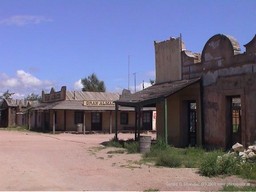
Main Street of Chupaderos, Dgo. |
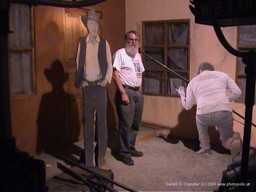
Gerry on a Movie Set at the Cine Museum |
We have already mentioned that Durango is where many western movies were shot in the 1960's and 1970's by both Mexican and American film companies, so it should be no surprise to learn that you can visit the old movie sets just outside of town.
We had hoped to visit two of them, but one was open only on weekends so we had to be satisfied with the other, which is now part and parcel of a real village. We wandered the streets and could just imagine Wyatt Earp or Doc Holliday coming around the corner to greet us. The buildings were largely shells, but you can imagine that it wouldn't take much to bring it back to life. Add a few men on horseback and women in long skirts, a buckboard or two (like the ones we saw in Bermejillo ) and you could be right back in the 19th century.
The movie theme continued during our visit to the cinema museum in downtown Durango. Perhaps the most interesting exhibit was the large collection of movie posters, all of them shot in the Durango area, though of course not all in Chupaderos. Many of the stars of these movies probably stayed at Campo Mexico Motel and may even have been waited on by a young Margaret Delgado who was hired by various film crews because of her fluency in both English and Spanish.
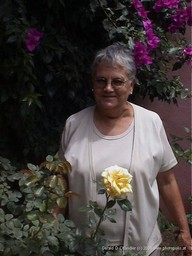
Margaret Delgado |
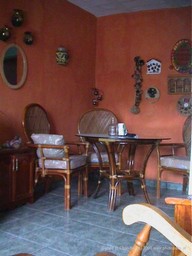
Margaret's Living Room |
We met the lady above when we asked her directions on the street. We were surprised to hear an American accent and learned that Margaret was born and brought up in the States of Mexican descent, married a Mexican American, and lived part of her adult life in Durango. She moved back to the States for several years to support her family and has been living in her lovely little retirement home here in Durango for the past ten years. We thanked her for her help by driving her home and she gave us a cup of tea and regaled us with stories of her eventful life.
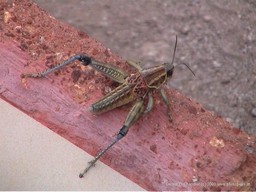
Durango Wildlife |
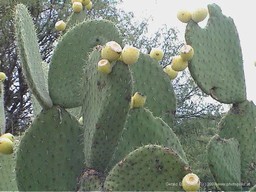
Durango Fruits |
Last, but by no means least, we were in Durango for Mexican Independence Celebrations. The great advantage of spending as much time in a country as we are in Mexico is that you have time to absorb the country's history. We had had a crash course in April, and now we had time to fill in the details. The central figure of the Mexican struggle for independence from Spain, is Miguel Hidalgo, and the most famous of his sayings or doings is the "Grito Mexicano" when he announced the independence of Spain with the cry "Viva Mexico". His cry, "El Grito", is the culminating point of every Independence Day Eve. We were lucky enough this year to be in Durango's 400th anniversary square to hear his cry repeated at full voice by the thousands of people crammed into the square. Everything about the celebration was good-natured, peaceful, and very enjoyable. As Gerry pointed out to a friendly Durango resident, everyone in Mexico assures the tourist that they are safe in their town, but it would be best not to trust those other towns.
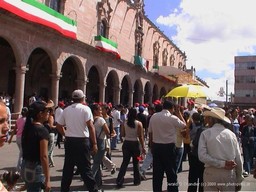
Mexican Independence Day Parade |
